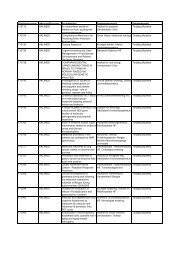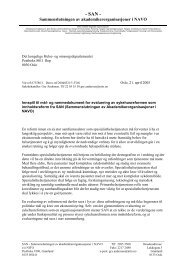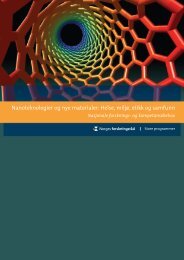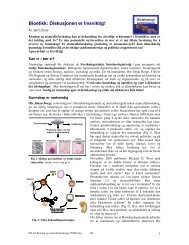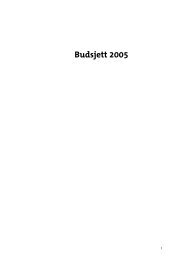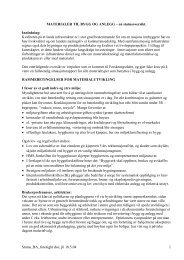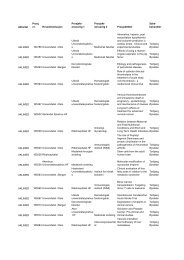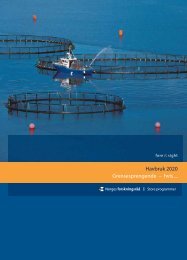A Revolution in R&D
A Revolution in R&D
A Revolution in R&D
You also want an ePaper? Increase the reach of your titles
YUMPU automatically turns print PDFs into web optimized ePapers that Google loves.
36<br />
Given these technological limitations, we estimate<br />
that less than 15 percent of drugs will be amenable<br />
to the application of pharmacogenetics.<br />
Desirability—Market Economics<br />
As already mentioned, there are circumstances <strong>in</strong><br />
which a company might have an <strong>in</strong>centive to shun<br />
pharmacogenetics entirely. After all, by exclud<strong>in</strong>g<br />
patients from trials, you are <strong>in</strong> effect giv<strong>in</strong>g the<br />
drug a restricted label when try<strong>in</strong>g to market it.<br />
Gaug<strong>in</strong>g the likely effect of a restricted label<br />
<strong>in</strong>volves some complex analysis. For a start, you<br />
need to consider two dist<strong>in</strong>ct groups of patients:<br />
those who take a prescription for the full course of<br />
treatment (which could last many years, or even the<br />
rema<strong>in</strong><strong>in</strong>g lifetime for those suffer<strong>in</strong>g from chronic<br />
diseases), and those who embark on a prescription<br />
but then discont<strong>in</strong>ue it for reasons of <strong>in</strong>efficacy or<br />
side effects.<br />
The pharmacogenetics test would shr<strong>in</strong>k these two<br />
potential patient groups <strong>in</strong> different ways. From the<br />
former, it would elim<strong>in</strong>ate the “placebo responders.”<br />
From the latter, it would elim<strong>in</strong>ate some of<br />
the nonresponders and negative responders.<br />
Market fragmentation has happened <strong>in</strong> many<br />
<strong>in</strong>dustries—the market<strong>in</strong>g group can’t put their<br />
heads <strong>in</strong> the sand. We have to figure out what to do<br />
about pharmacogenetics.<br />
—Genetics director,<br />
lead<strong>in</strong>g biotech company<br />
S<strong>in</strong>ce pharmacogenetics seems to be chipp<strong>in</strong>g away<br />
at a drug’s market base, why pursue it <strong>in</strong> the first<br />
place? The answer may lie, <strong>in</strong> part, <strong>in</strong> competitive<br />
dynamics and game theory: companies may have to<br />
embrace pharmacogenetics because their competitors<br />
are do<strong>in</strong>g so. Merck & Co., for example,<br />
accord<strong>in</strong>g to a recent Wall Street Journal article, is<br />
busy develop<strong>in</strong>g capabilities to reproduce pharmacogenetic<br />
analyses conducted by its competitors, if<br />
only to disprove any claims that a rival drug might<br />
be superior to its own.<br />
But the compensatory advantages can be more positive,<br />
too—the potential for market upside, once<br />
aga<strong>in</strong>: price premium, share shift, and new patients.<br />
What a company has to judge, before adopt<strong>in</strong>g<br />
pharmacogenetics for any drug <strong>in</strong> development, is<br />
the likely breakeven po<strong>in</strong>t—the po<strong>in</strong>t at which a<br />
price premium or <strong>in</strong>creased market share beg<strong>in</strong>s to<br />
offset the volume loss. Our model assumes a modest<br />
market premium of 20 percent, and calculates the<br />
breakeven po<strong>in</strong>t <strong>in</strong> various scenarios, based on four<br />
different approaches to pharmacogenetics. (See<br />
sidebar, “Pharmacogenetics—Four Applications,”<br />
and Exhibit 10.)<br />
Efficacy-based pharmacogenetics can reduce trial costs<br />
considerably. But the market dynamics could then<br />
cast a cloud over that economic picture. If the<br />
restricted label, by disqualify<strong>in</strong>g placebo responders<br />
and some nonresponders and negative responders,<br />
translates <strong>in</strong>to an overall revenue loss of just 2<br />
percent, that cancels out the sav<strong>in</strong>gs achieved <strong>in</strong> the<br />
cl<strong>in</strong>ical trials.<br />
EXHIBIT 10<br />
PHARMACOGENETICS’ VALUE DEPENDS ON MARKET<br />
DYNAMICS<br />
Patients lack<strong>in</strong>g good response (%) 1<br />
100<br />
80<br />
60<br />
40<br />
20<br />
0<br />
Conduct normal trials<br />
Abandon drug<br />
100<br />
SOURCES: Industry <strong>in</strong>terviews; BCG analysis.<br />
Pharmacogenetics can optimize cl<strong>in</strong>ical trials<br />
200<br />
Pharmacogenetics<br />
trials make drug viable<br />
300<br />
Revenue <strong>in</strong>crease required from market premium (%)<br />
1Example based on a scenario <strong>in</strong> Nature Biotechnology, vol. 18, May 2000<br />
of ApoE4 efficacy <strong>in</strong> tacr<strong>in</strong>e response; assumes response rate of 41 percent<br />
among patients with the SNP versus 20 percent among those without it;<br />
also assumes 50 percent of nonresponders discont<strong>in</strong>ue.



